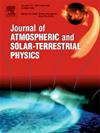One-hour-ahead solar irradiance forecast based on real-time K-means++ clustering on the input side and CNN-LSTM
IF 1.8
4区 地球科学
Q3 GEOCHEMISTRY & GEOPHYSICS
Journal of Atmospheric and Solar-Terrestrial Physics
Pub Date : 2025-01-01
DOI:10.1016/j.jastp.2024.106405
引用次数: 0
Abstract
With the increasing proportion of photovoltaic power generation in the power system, accurate solar irradiance forecasting is crucial for power grid scheduling. The paper proposes a approach of clustering modeling and joint forecasting for solar irradiance: firstly, by using the real-time K-means++ to cluster the GHI sequence on the input side of the model, the model input is divided into 4 clusters. The number of clusters and clustering methods are quickly determined through sensitivity experiments. Then 4 CNN-LSTM models, corresponding to the 4 clusters, are separately established and trained to fully extract multivariate and multi-temporal information from the input side. These 4 models are combined to achieve 1-h-ahead solar irradiance forecast with higher accuracy. To verify the effectiveness of the proposed method, Auto regressive (AR), Convolutional neural network (CNN), Long short-term memory (LSTM) and Gradient boosting decision tree (GBDT) are used as comparative models. The results indicate that the proposed K-means++_CNN-LSTM is a feasible method, with MAE decreasing by about 9.13%, RMSE decreasing by about 6.58%, and increasing by about 1.46%, compared to K-means++_AR. Finally, T-test is used to verify the positive impact of the proposed framework on model accuracy.
基于输入端的实时k -means++聚类和CNN-LSTM的1小时前太阳辐照度预报
随着光伏发电在电力系统中的比重越来越大,准确的太阳辐照度预测对电网调度至关重要。本文提出了太阳辐照度的聚类建模与联合预测方法:首先,利用实时k -means++对模型输入侧的GHI序列进行聚类,将模型输入分为4个聚类;通过灵敏度实验,快速确定聚类数量和聚类方法。然后分别建立并训练4个CNN-LSTM模型,从输入侧充分提取多元、多时相信息。这4种模式相结合,可实现提前1小时的太阳辐照度预报,预报精度更高。为了验证该方法的有效性,采用自回归(AR)、卷积神经网络(CNN)、长短期记忆(LSTM)和梯度增强决策树(GBDT)作为比较模型。结果表明,k -means++_CNN-LSTM是一种可行的方法,与k -means++_AR相比,MAE降低了约9.13%,RMSE降低了约6.58%,ρ提高了约1.46%。最后,使用t检验验证了所提出的框架对模型精度的积极影响。
本文章由计算机程序翻译,如有差异,请以英文原文为准。
求助全文
约1分钟内获得全文
求助全文
来源期刊

Journal of Atmospheric and Solar-Terrestrial Physics
地学-地球化学与地球物理
CiteScore
4.10
自引率
5.30%
发文量
95
审稿时长
6 months
期刊介绍:
The Journal of Atmospheric and Solar-Terrestrial Physics (JASTP) is an international journal concerned with the inter-disciplinary science of the Earth''s atmospheric and space environment, especially the highly varied and highly variable physical phenomena that occur in this natural laboratory and the processes that couple them.
The journal covers the physical processes operating in the troposphere, stratosphere, mesosphere, thermosphere, ionosphere, magnetosphere, the Sun, interplanetary medium, and heliosphere. Phenomena occurring in other "spheres", solar influences on climate, and supporting laboratory measurements are also considered. The journal deals especially with the coupling between the different regions.
Solar flares, coronal mass ejections, and other energetic events on the Sun create interesting and important perturbations in the near-Earth space environment. The physics of such "space weather" is central to the Journal of Atmospheric and Solar-Terrestrial Physics and the journal welcomes papers that lead in the direction of a predictive understanding of the coupled system. Regarding the upper atmosphere, the subjects of aeronomy, geomagnetism and geoelectricity, auroral phenomena, radio wave propagation, and plasma instabilities, are examples within the broad field of solar-terrestrial physics which emphasise the energy exchange between the solar wind, the magnetospheric and ionospheric plasmas, and the neutral gas. In the lower atmosphere, topics covered range from mesoscale to global scale dynamics, to atmospheric electricity, lightning and its effects, and to anthropogenic changes.
 求助内容:
求助内容: 应助结果提醒方式:
应助结果提醒方式:


